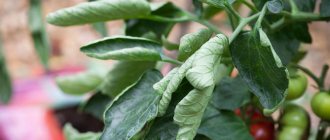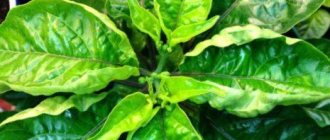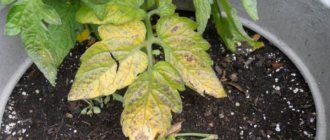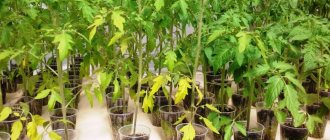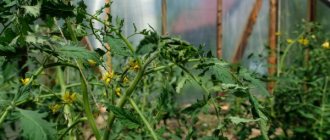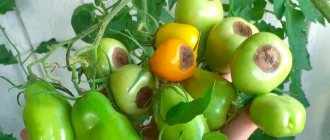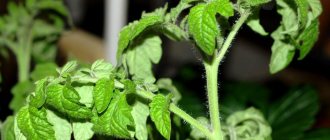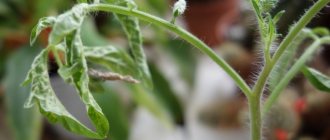There are many reasons why tomato leaves can curl. And among them there may be not only infections or a lack of nutrients, but also quite harmless circumstances. It is important to determine exactly which ones and only then decide what to do in this situation.
First of all, carefully examine the plants. In addition to curled leaves, you will probably find other “bells” as well. And once the problem is identified, it is important to immediately begin to act by using the appropriate remedy. For what reasons do tomato leaves curl?
Deviations from the thermal regime
Temperature fluctuations are the main reason why tomato leaves curl and dry in a greenhouse. Exorbitant temperatures in the greenhouse and hot, sultry weather when cultivating tomatoes in the garden are extremely unfavorable phenomena.
Important! The optimal temperature for greenhouse tomatoes is +22 degrees during the day and +18 degrees at night.
Temperatures above +30 degrees put plants under stress. To reduce the evaporation of precious moisture, tomato leaves are rolled into a tube. With the onset of twilight they spread out again.
To eliminate this reason for healthy tomato leaves curling in a greenhouse, you need to:
- open doors, transoms;
- whitewash the roof with chalk;
- curtain with a special fabric.
In extreme heat, garden tomato beds can be shaded and the tomatoes can be fed with nitroammophos at the rate of 20 g per 1 m², having previously dissolved the fertilizer in water.
You also need to water the tomatoes so that they do not curl with increased water in the morning or evening hours. The row spacing should be mulched with straw (sawdust).
If the heat in the greenhouse causes the leaves to curl inward, you can try spraying the plantings with a urea solution prepared according to the following recipe:
- urea – 2 tbsp. l.;
- water – 10 l;
- consumption of the prepared liquid – for 10 bushes.
After waiting a few days, it is recommended to re-treat the tomatoes against leaf curl with potassium sulfate, dissolving 10 g in 10 liters of water. This solution is enough for 10-11 bushes.
Gardening tips
When placing tomatoes in a greenhouse, you should maintain a distance of 40-70 cm between plants. The layout of the beds depends on the shape of the plant. If the tomatoes form into 1 stem, the bushes are planted more densely; if they form 2-3 stems, they are placed more spaciously.
In the process of caring for plants, all leaves below the fruit clusters are removed. These leaves are no longer beneficial for the plant.
Important! Good air circulation in the greenhouse is the key to healthy plants.
When removing shoots from a tomato, leave a stump 1 cm long. The stump will prevent new shoots from forming in this place.
Plants should be watered and fed by watering at the roots, without soaking the tops (with the exception of foliar feeding with microelements or treatment against diseases). Irrigation water should be warm.
Acute moisture deficiency
A common reason why the leaves of tomato seedlings curl up in a boat is a lack of moisture. It is recommended to water tomatoes abundantly and regularly, without long breaks.
A high need for moisture in tomatoes occurs after planting seedlings in garden beds or in a greenhouse. At this point, it is advisable to pour 4 liters of liquid onto each bush. After waiting 10 days, it is recommended to re-water, increasing the watering rate by 50%.
The following is based on the weather:
- if it’s hot and the tomatoes are slightly wilted, you need to water them twice a week;
- in cool weather, 1 irrigation per week is sufficient.
When the ovaries begin to form, the watering rate is increased by 1/3.
Experiencing a moisture deficit, the tomato begins to reduce the proportion of evaporated moisture and the leaves of the plant curl inward. Having noticed this, you should immediately start watering.
Photo. Tomatoes suffering from moisture deficiency
Lack of soil nutrition elements
The next reason why the leaves of tomato seedlings wither and curl is a lack of certain nutrients. Due to a lack of certain elements, the upper or lower leaves of the plant curl up or down; let’s look at how to deal with this deviation.
Phosphorus deficiency
With a small amount of phosphorus, the leaves curl upward, and the underside of the leaf blade turns purple. This disease can be cured by applying superphosphate under tomato bushes. Do the following work:
- 150 g of superphosphate pour 1 liter of boiling water;
- leave the composition for 20 hours;
- Dilute the extract with 10 liters of water;
- Water the resulting solution at the rate of 500 ml under the tomato bush.
Important! You can limit yourself to adding dry ash under the bushes, then you will have to wait a week longer for the result.
Copper deficiency
Copper is important in growing tomatoes. Copper deficiency is less common than others, especially when bushes are treated with Bordeaux mixture against fungal diseases.
Symptoms of copper deficiency:
- the edges of the leaves curl up;
- random blurry yellow spots appear on the leaf blade;
- then the tomato leaves turn black and die, as shown.
How to save the plant in this case? Experienced gardeners recommend spraying the bushes with any copper-containing preparation.
Important! Using this method, you can compensate for copper deficiency and protect tomato bushes from a number of diseases.
Little potassium in the soil
If the leaves curl up into a tube, a brown border appears along their edges - this is a symptom of a lack of potassium for nutrition. Treatment for such twisting is carried out by applying potassium fertilizer.
Potassium nitrate contains potassium and some nitrogen.
The solution is prepared and added as follows:
- dilute 1 tbsp. l. saltpeter in 10 liters of water;
- stir until completely dissolved;
- water, spending 500 ml for each bush.
Adherents of folk remedies for combating tomato diseases can treat with ash extract according to the following recipe:
- Pour boiling water over 100 g of ash;
- leave the composition for a day;
- every 2 hours the solution must be stirred;
- strain the solution;
- water the tomatoes at the root level at the rate of 500 ml per bush.
Important! You can spray tomato bushes with an ash solution; for better adhesion, it is advisable to add 30 g of soap to the composition.
Nitrogen deficiency
Nitrogen starvation occurs on depleted soils and when technology requirements are neglected. If there is insufficient nitrogen, the plant develops a yellow tint and the upper leaves become smaller.
When the leaves begin to lighten and curl downward, the tomatoes are experiencing severe nitrogen starvation. Then the leaves become yellow and dry out.
It is urgent to apply nitrogen fertilizer. Nitrogen starvation can be stopped by watering the bushes with herbal infusion.
Small proportion of calcium in the soil
The calcium type of starvation causes the leaf blade to curl upward, and the fruits are affected by blossom end rot.
How to feed tomatoes in such a situation? Vegetable growers use the following recipe:
- calcium nitrate – 21 g;
- ash – 380 g;
- urea – 11 g.
Important! All ingredients are diluted in a bucket of water, mixed and the solution is used for root feeding. One bucket is enough for 4 m² of plantings.
Main causes of twisting
Depending on the cause of the change in leaf shape, a treatment strategy is chosen. The source of infection can be determined by examining the nature of damage to leaves, tomato stems, and soil around the plants.
Incorrect pinching or pinching of tomatoes
Leaves may curl up or down. This occurs due to stress in the plant if too many stepsons or large shoots have been removed.
Important! If pinning is done incorrectly, the yield will decrease.
Overdose of organic fertilizers
After excessive feeding with fresh manure, the following may occur:
- root damage due to ammonia burn;
- an excess of nitrogen - the stem becomes thick, the leaves become dense, the bush itself becomes dark green, the upper leaves of the plant curl down into a ring;
- phosphorus deficiency - the edges of the leaves turn up, then bend down, become dark with purple veins, the bush grows slowly, the stem becomes brittle.
Violation of watering rules: underwatering and overwatering
If the edges of the leaf blades curl down, this is a signal of a lack of moisture. At the same time, the leaves become soft and limp.
If fragile leaves curl upward in an attempt to increase evaporation, this indicates an excess of moisture.
Root damage
If the plant is transplanted incorrectly into open ground, mechanical damage to the roots occurs. The leaves curl along their entire length and fall down.
When the roots are damaged by underground pests (mole crickets, wireworm larvae, root-knot nematodes), the tomato leaves curl into a ring and fall down.
How to recognize root system pests:
- mole cricket - holes and tunnels up to 2.5 cm are visible in the ground;
- the wireworm larva eats holes in the roots and crawls inside the stem;
- root-knot nematode - swellings and nodules form on the roots.
Tomato infections
Warm greenhouse conditions are characterized by:
- Bacterial cancer . Appears when the humidity in the greenhouse is more than 80% every day, the tomatoes do not have enough light, there is too much moisture, and the constant temperature is above +25 °C. How to find out? The plant turns yellow, the edges of the leaf blades curl on one side, the other retains its original shape. In the middle tier of the plant, ulcers and necrotic spots appear, the leaves dry out but do not fall off, the stem cracks, yellow mucus flows from the cracks, its core turns yellow, and the fruits become covered with white spots.
- Tobacco mosaic is a virus that affects tomatoes when there is little light, poor ventilation of the greenhouse, dense planting, excessive watering and air humidity above 80%. The leaves of the plant are completely curled, covered with yellow spots, swollen, and the fruits stop growing.
- Verticillium wilt is a fungal disease that occurs after excessive watering of dry soil and when the temperature decreases to 20 °C or below. Young tops of tomatoes curl inward at the edges, turn yellow and dry out, the stem becomes light brown when cut, necrosis develops and the roots die.
Tobacco mosaic virus on tomatoes
Pests
Pests infect tomato leaves, feed on their juice, and most often settle on the reverse side:
- The potato aphid is a small red or green insect. Drinks juice from young leaves at the top, causing their edges to bend upward. Tomatoes have sticky spots from honeydew secreted by aphids.
- Whitefly is a white midge that flies away from a bush when a person approaches it. The juice of tomatoes is drunk by whitefly larvae, which look like gray specks of dust that stick around the entire bush. The leaves become limp, pale yellow spots are visible around the bites, and under them there are dark and light sticky spots. What to do with tomatoes when the leaves are curled up in a boat? Fight whitefly.
- Spider mite . Its presence explains why the leaves of tomatoes curl inward in a greenhouse. In this case, the lower leaves of the plant suffer. Over time, the mites form a whole web, and the surface of the leaf becomes covered with white or colorless areas.
Excessive nutrient content
Some summer residents, in pursuit of high yields, apply a lot of mineral fertilizers. As a result, the leaves dry out and turn yellow, not because the plants lack something, but because of the application of excess fertilizers. Let's see what happens to tomatoes that are overfed with nutrients.
Excess nitrogen
If the soil contains an excess amount of nitrogen, the tops of the tomatoes curl, but the remaining leaves look quite normal.
Elimination of the problem: to correct the situation, immediately stop nitrogen fertilizing. To neutralize the effects of nitrogen, add potassium sulfate or ash extract to the soil.
Excessive amount of zinc
With excess zinc content, tomato leaves curl upward, and it may seem that the bushes do not have enough moisture. However, on the lower tier of the tomato bush, a secondary symptom of zinc overfeeding occurs - a purple color on the leaves and stems.
Elimination of the problem: you need to stop fertilizing and add organic matter.
Lots of manganese in the soil
If there is too much manganese in the soil, the leaves first curl, then become corrugated and turn bright green.
Elimination of the problem: you should stop feeding tomatoes with microelements.
Eliminating the causes and preventing curling
When curled leaves are detected on tomatoes, the first step is to adjust the growing conditions of the crop. Tomatoes are demanding in terms of watering and fertilizing; every mistake in care can critically affect the yield.
| Cause of twisting | How to fix | How to prevent |
| Incorrect pinching or pinching | Plants are fed with nitrogen, phosphorus or potassium foliar fertilizers. | Stepchildren are removed on time and according to the scheme prescribed for a specific plant variety. It is optimal to pick off 2-3 leaves per week, and break off the stepsons until they reach 5 cm. |
| Overdose of organic fertilizers | Excess nitrogen can be eliminated by adding potassium sulfate (8-10 g per 1 m²) or ash (50-80 g per 1 m²) to the soil. To flush nitrogen from the soil, tomatoes are watered generously. Stepchildren that have reached 12-18 cm are removed. If there is a lack of phosphorus, they are fed with superphosphate according to the scheme specified in the instructions. | Fresh manure, even many times diluted with water, is dangerous for the plant when feeding roots. Tomatoes are fertilized with special preparations suitable for the variety, soil, climate, and growing conditions. |
| Violation of watering rules: underwatering and overwatering | If the plants lack moisture, you need to start watering - every day in small portions. If overflow occurs, stop irrigation for 1-2 weeks. | Tomatoes love moisture. Young plants that have just been planted in the ground are watered in small volumes 2 times a day until they are completely rooted. After this, water 1-2 times a week. When the bushes have bloomed and fruits have begun to set, watering is increased as for young plants. The rest of the time, they don’t pour under a bush. Spray warm, settled water, preferably well water, dropwise in moderate portions |
| Mechanical damage to roots | The bushes are fed with phosphorus fertilizer by spraying to stimulate the root system | Carefully transplant the plant into the ground. Method: Fill a tomato in a pot with water, carefully remove it and transplant it into the prepared hole. Rooted tomatoes are loosened without touching the roots. If the root system is damaged, there is no need to worry, the plant can restore its roots on its own - the leaves will unfold and become normal in shape. |
If there are no violations of agricultural practices, and damage on the leaves indicates the presence of a disease or pests, therapeutic and preventive measures are carried out.
| Name of disease or pest | How to fix |
| Bacterial cancer | There is no treatment. The bushes are dug up and burned. Uninfected tomatoes are treated with copper preparations: Bordeaux mixture, copper chloroxide or copper sulfate. The best time for processing is from 10 to 12 or from 16 to 18 hours. |
| Tobacco mosaic | It also cannot be treated. You can help the tomato by removing the affected leaves to healthy tissue. To prevent the disease from affecting healthy bushes, they are treated with whey (a solution for dilution with water 1:1). Spraying is carried out every week, even after the fruits ripen. |
| Verticillium wilt | The infected plant is dug up along with the roots and burned. The soil where the affected tomato grew is replaced. To prevent other plants from getting sick, spray them with an aqueous soap-ash mixture twice with a 10-day break. To prevent the leaves of the plant from curling due to verticillium wilt, foliar feeding is carried out - 2 g of zinc sulfate, 3 g of boric acid, 5 g of magnesium nitrate per bucket of water. Spray with this mixture 3 times every 15-20 days. |
| Potato aphid | Leaves affected by aphids are removed, and the plant is doused with water to wash away other insects. For minor lesions, wipe the leaves with soapy water or spray with bioinsecticides: Akarin, Bitoxibacillin. For large lesions, they are treated with chemicals: Trichlorometaphos, Aktara, Biotlin. Traditional recipes are used. Tobacco infusion: 400 g of dry tobacco leaves are cut, pour 1 bucket of boiling water, leave for 5 days. Herbal decoction (one to choose from): yarrow, wormwood, marigold, chamomile, celandine, dandelion. Pour 1 liter of boiling water over 500 g of chopped green parts of the plant and boil for 20 minutes. Leave for 2 days and spray on the affected leaves. |
| Whitefly | For small lesions, it is better to fight it with biological agents: Verticillin, Boverin. You can introduce macroflora, encarsia or amblyseius, that is, predatory insects, into the greenhouse. Fumigation of plants with tobacco sticks is suitable: 3 times every 10 days. For extensive lesions, spray with insecticides: “Aktellik”, “Tanrek”, “Inta-Vir” |
| Spider mite | Leaves affected by mites are removed. Wipe or spray the tomatoes with soapy water or horseradish infusion. The bucket is filled 1/3 with chopped horseradish shoots and leaves, filled to the brim with water, after an hour, filtered and sprayed on the tomatoes. Repeat after 12 days. Special biological products that kill ticks: Fitoverm, Kraft. Chemicals: Oberon, Borneo. "Apollo" |
| Medvedka | The mole cricket eats up the roots of the plant, so it will not be possible to revive them. They fight the pest with granular baits: “Medvetox” or “Thunder” |
| Wireworm | Remove the wireworm by pouring a slightly pink solution of potassium permanganate under the bush. Chemical preparations include Diazolin 10-RG, Provotox or Bazudin granules. |
| Root nematode | Damaged plants die. They are dug up and destroyed. Bushes are not treated against this pest. After harvesting, the soil in the greenhouse is changed. |
Mechanical root injuries
After placing young seedlings in a permanent place, their leaves curl a little; this should not frighten the vegetable grower. In a week the bushes will look quite normal. If recovery does not occur, then the bushes should be treated with stimulating drugs.
Sometimes vegetable growers injure the roots when weeding and loosening tomatoes. As a result, the leaf plates curl upward along the entire length of the bush. To support the plants, you need to water the tomatoes so that they do not curl with a stimulating drug:
- Kornevin;
- Epin Extra;
- Cornerost;
- Zircon.
Preventive actions
By following simple preventive measures, you will not have to use pesticides or spend money on purchasing additional fertilizers:
- take high-quality seeds for sowing, and before planting, treat them in a solution of potassium permanganate;
- maintain a stable temperature in the greenhouse through frequent ventilation;
- water the bushes regularly - often, but moderately, which will help avoid waterlogging and the development of various sores;
- periodically spray the garden bed with insecticides and fungicides to prevent the appearance of diseases and pests;
- follow the rules of crop rotation - planting tomatoes in a bed where crops of the Solanaceae family previously grew is allowed only after three years;
- adhere to the planting scheme for bushes, since in crowded conditions they begin to get sick and suffer from a lack of moisture, light and nutrients;
- regularly weed between the rows, loosen the soil, remove weeds that often harbor harmful insects;
- After harvesting, clear the area of unnecessary vegetation and fallen fruit.
Violation of pinching technology
The leaves at the top of the bush and in its central part curl due to improper execution of the pinching procedure. Stepchildren grow from each leaf axil; they should be removed by breaking them off at a length of 5 cm. When the formation of bushes is delayed and the stepsons are broken out late, leaf curling begins.
Important! If overgrown stepsons have been removed and the tomato leaves have curled, you should spray the bushes with Zircon.
Tomato diseases
Curling of leaves on tomato bushes in greenhouse conditions can also be observed in some diseases. Tomatoes can get sick under different circumstances: if they are densely planted, placed in areas where related nightshades used to grow, and if agrotechnical rules for growing plants are violated.
Among the diseases characteristic of tomatoes, stolbur disease has such a symptom as leaf curling. It is the appearance of this disease that can answer the question of why the tops of tomatoes wither, the top leaves of tomatoes become deformed and curled, and their color changes to light pink or purple. Another symptom by which stolbur disease can be identified is that the lower leaves of plants usually turn yellow. To treat this disease, you can use the drug Phytoplasmin, from which you can observe the maximum possible effect. Before spraying plants, prepare a working solution of this drug in accordance with the instructions supplied with it.
Pest exposure
Pests also cause damaged leaves of tomatoes to curl in greenhouses and open ground. Below are the most harmful insects that damage leaves.
Whitefly
This small white butterfly is a serious pest of greenhouse tomatoes. The butterfly and its larvae drink tomato juice, secreting sweet honeydew. This sticky mass is colonized by sooty fungus. As a result, the leaves curl into a tube and the tomatoes turn black, which leads to a significant loss of yield.
In case of focal spread of the pest, Fitoverm is used. If the spread of butterflies has become widespread, carry out 3 treatments at weekly intervals with Aktara.
Aphid
It is mainly garden tomatoes that suffer from the effects of aphids. The insect sucks the sap, causing the upper leaves to curl.
To destroy aphids, the following means are used:
- Spark;
- Proteus;
- Aktara.
Spider mite
This pest is classified as sucking. As a result of the influence of the mite, the leaves of tomatoes in the greenhouse begin to curl and dry out.
You can control the number of ticks using acaricidal agents:
- Flumaita;
- Borneo;
- Oberon.
Impact of insects on tomato leaves
There are many store-bought preparations for pest control, but they must be used very carefully in heifers. If the tomatoes were planted in an open garden, some of the harmful substances would evaporate, but they are absorbed into the plant itself, and this is very dangerous.
Therefore, for heifers, it is more advisable to use folk remedies, such as a decoction of onion or garlic peels, celandine, laundry soap or wood ash.
Aphid
It loves juicy young leaves and settles on their underside. When a pest attacks, plant development stops. Having discovered aphids, you need to tear off the affected leaves and burn them, and treat the entire plant with insecticides. Many are accustomed to the fact that aphids are yellow insects that are not at all difficult to see, but today there are many varieties of them and some live not on leaves, but in the ground, climbing onto the plant only to feed, even laying eggs in the soil. Infestation by aphids can also be indicated by curling of the leaves and the appearance of yellow spots on them. The best preventive measure is treatment with a solution of laundry soap (one bar per bucket of water; to enhance the effect, you can add a liter of wood ash to it). Also, to repel the pest, you can lay onion or garlic peels, celandine or wormwood along the beds.
Whitefly
This butterfly is very dangerous. And in an open area, it can literally destroy all plantings in a couple of nights, but in a greenhouse the conditions are much better for it, and the tomatoes are tastier and juicier. This midge is small, the body is no more than 3 mm with four white wings. The main sign of damage is a white coating on the leaves that looks and feels like flour. Afterwards, the leaf seems to be covered with sticky oil or varnish and becomes shiny. The next stage is curling, withering.
If the bush is covered with whiteflies, touch it enough and a white cloud will fly up.
The easiest way to combat it is to hang sticky tapes throughout the greenhouse, just like for catching flies. If there is an outlet, you can turn on the fumigator, or buy a special flashlight that attracts insects not only with light, but also with smell.
Garlic infusion also helps a lot. To prepare it, you need to pour 150 grams of garlic with a liter of water and let it brew under a closed lid for a week. Then dissolve a tablespoon in a liter of water and thoroughly spray all the leaves, and if there is a suspicion of infection, then you should not spray, but coat the entire plant with a brush.
Spider mite
The presence of this pest on plantings is very simple. A thin cobweb appears between the leaves, which is visible to the naked eye.
Infection occurs through plant debris, and is also provoked by planting certain flowers, which many gardeners like to place next to tomatoes, hoping that they will decorate the beds and repel insects with their smell.
The following remedies will help fight spider mites:
- Infusion of dandelion leaves. 400 grams of leaves are poured into a bucket of water and left in the sun for 24 hours. Afterwards, spraying is carried out and watering a glass under each bush. Repeat after two weeks.
- Horseradish tincture. Grind the leaves and roots of the plant, fill the bucket a third, fill it to the top with boiling water, let it cool and use it for spraying once every 20 days.
- Dusting with wood ash or tobacco dust. This is done approximately an hour after watering. Then do not water the plants for two days.
If no signs of pest damage are found, and the tomatoes curl and wither, there may be another reason.
Diseases of culture
Diseases are also the cause of leaves curling in tomatoes growing in greenhouses and open ground.
| Name of the disease | Symptoms | Control measures |
| Stolbur |
| The effect is achieved by treatment with Phytoplasmin. |
| Bacterial cancer |
|
|
Important! When treating for cancer, try to completely wet all the leaves with the chemical. It is advisable to wet the soil surface as well.
Prevention measures
To prevent tomatoes' leaves from curling, it is important to follow the rules of agricultural technology. If the microclimate, watering and fertilizing regime are observed, the plants develop normally and bear fruit.
The following recommendations will help you avoid leaf curling in tomatoes:
- selection of varieties resistant to unstable climates;
- compliance with crop rotation;
- disinfection of seeds, greenhouses and garden tools;
- careful replanting of plants and loosening of the soil;
- constructing a shelter for tomatoes before frost;
- rationing of watering, control of soil moisture;
- regular ventilation of the greenhouse;
- weeding;
- correct pinching of bushes.
It is important to provide tomatoes with protection from diseases and pests. To prevent planting, they are sprayed with biological preparations Fitoverm and Fitosporin. Their active substances do not accumulate in fruits. Before fruiting begins, chemicals are used: Aktara, Karbofos, Iskra.
Folk remedies help protect plantings: dusting with wood ash, watering with infusion of garlic or wormwood. The best agricultural technology against pests is digging up the soil in spring and autumn, disinfecting seeds, and weeding.
